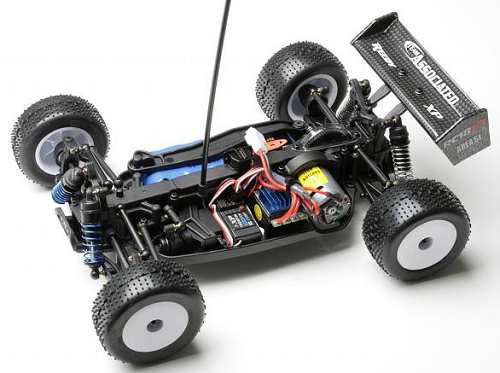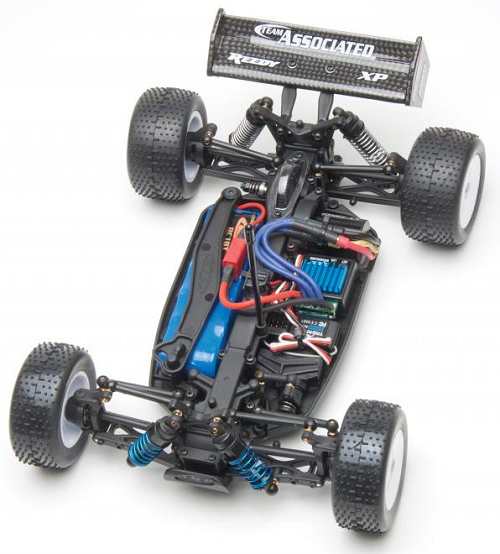

|
|
|


|
|
1/18 Scale Electric Buggy:
Team Associated RC18B2 - 20106 / 20108 - Radio Controlled ModelHistory and Information for the RC18B2:
Introduced by Team Associated in 2010, the 4WD RC18B2 Mini Buggy RTR - # 20106 - is 2 belt driven on a molded composite chassis, with gear type differentials, coil spring over oil filled dampers, dogbone drive-shafts, a full set of ball bearings and came with a Super-370 motor, XPS ESC and an XP3-SS 3-channel 2.4 GHz radio system.
▼ Scroll Down for More Images ▼
|








|
|
|

★ Team Associated RC18B2 Chassis ★

★ Team Associated RC18B2 BL Chassis ★

|
Buying a Used Team Associated RC18B2 Buggy (and What to look for)
Make a General Visual Inspection
Check the Body-Shell
If the body shell of your Team Associated RC18B2 is broken, ripped or damaged in any way, this can be easily repaired with rubber solution glue. Also, for added protection and if available for your RC18B2 model, fit an under guard to stop dirt and gravel entering the chassis. Drive Shafts and Turnbuckles
Examine the Drive System
Drive Belts need checking at regular intervals for wear, tension and damage. If deemed necessary, adjust the tensioning pulley until the belt can be depressed in the centre by no more than around 5mm. If the belt was slack, also examine the drive pulleys for wear. The teeth should provide a well seated fit for the belt teeth and not be rounded on the corners. If the belt teeth do not fit snugly, change the pulleys as soon as possible. For top level racing it may be prudent to replace all belts and pulleys after each race meeting. Pinions and Spur Gears
Don't Neglect the Ball-Joints
Ball joints always cause problems. For top level Electric Buggy racing, the plastic ball connectors should be checked and if deemed necessary changed after every meeting. A simple thing like a loose fitting connector popping off could easily end your race, so better safe than sorry. Steering Servo and Servo-Saver
Stabilizers
If body roll on your Team Associated RC18B2 is a problem, handling can be improved with the use of stabilizers, anti roll or sway bars, stiffer tuning springs and, or, thicker silicone oil in the dampers. Don't Forget those Bearings
▼ Scroll Down for More Articles and Advice ▼
Or, check out our RC Model Car Setup Guide
|
|
Manufacturers and Brands Catalogued, Listed and Reviewed by RC-Scrapyard.
At present, the RC Model Manufacturers, Brands and Distributors covered by us are: ABC Hobby, Academy, Acme Racing, Agama Racing, Amewi, Ansmann Racing, ARRMA, Team Associated, Atomic RC, Axial, AYK, Bolink, BSD Racing, Capricorn, Carisma, Carson, Caster Racing, Cen, Corally, Custom Works, Durango, Duratrax, ECX - Electrix, Exceed RC, FG Modellsport, FS-Racing, FTX, Fujimi, Gmade, GS-Racing, Harm, HBX, Helion, Heng Long, Himoto Racing, Hirobo, Hitari, Hobao, Hong-Nor, Hot Bodies, HPI, HSP, Intech, Integy, Jamara, JQ Products, Kawada, Kyosho, Losi, LRP, Maisto, Mardave, Marui, Maverick, MCD Racing, Megatech, Mugen, New Bright, Nichimo, Nikko, Nkok, Ofna, Pro-Pulse, Protech, PTI, RC4WD, Redcat Racing, RJ-Speed, Robitronic, Schumacher, Seben, Serpent, Smartech, Sportwerks, Step-Up, Tamiya, Team-C Racing, Team Magic, Thunder Tiger, Tomy, Top Racing, Traxxas, Trinity, Tyco, Vaterra RC, Venom, VRX Racing, WLToys, X-Factory, Xmods, Xpress, Xray, XTM, Yankee RC, Yokomo, ZD Racing and Zipzaps. |
|
Hints, Tips and Information
Sway Bars
On most forms of RC model cars, Sway Bars, also referred to as Stabilizers, Torsion Bars, or more commonly in some parts as Anti Roll Bars, are often nothing more than a short length of spring steel, clamped to the chassis or sometimes the gearbox of the car, extending out to the lower wishbones direct or connected to the wishbones using short adjustable or fixed length links and ball joints, depending on their position. |
|
Hints, Tips and Information
Bearing Seals
If you were to ask anyone with a modicum of experience in RC, they will tell you that the best modification you can make to a basic RC model, is to add a set of ball bearings. |
|
RC Models:
|
Radio & Motors: |
Other
Accessories: |